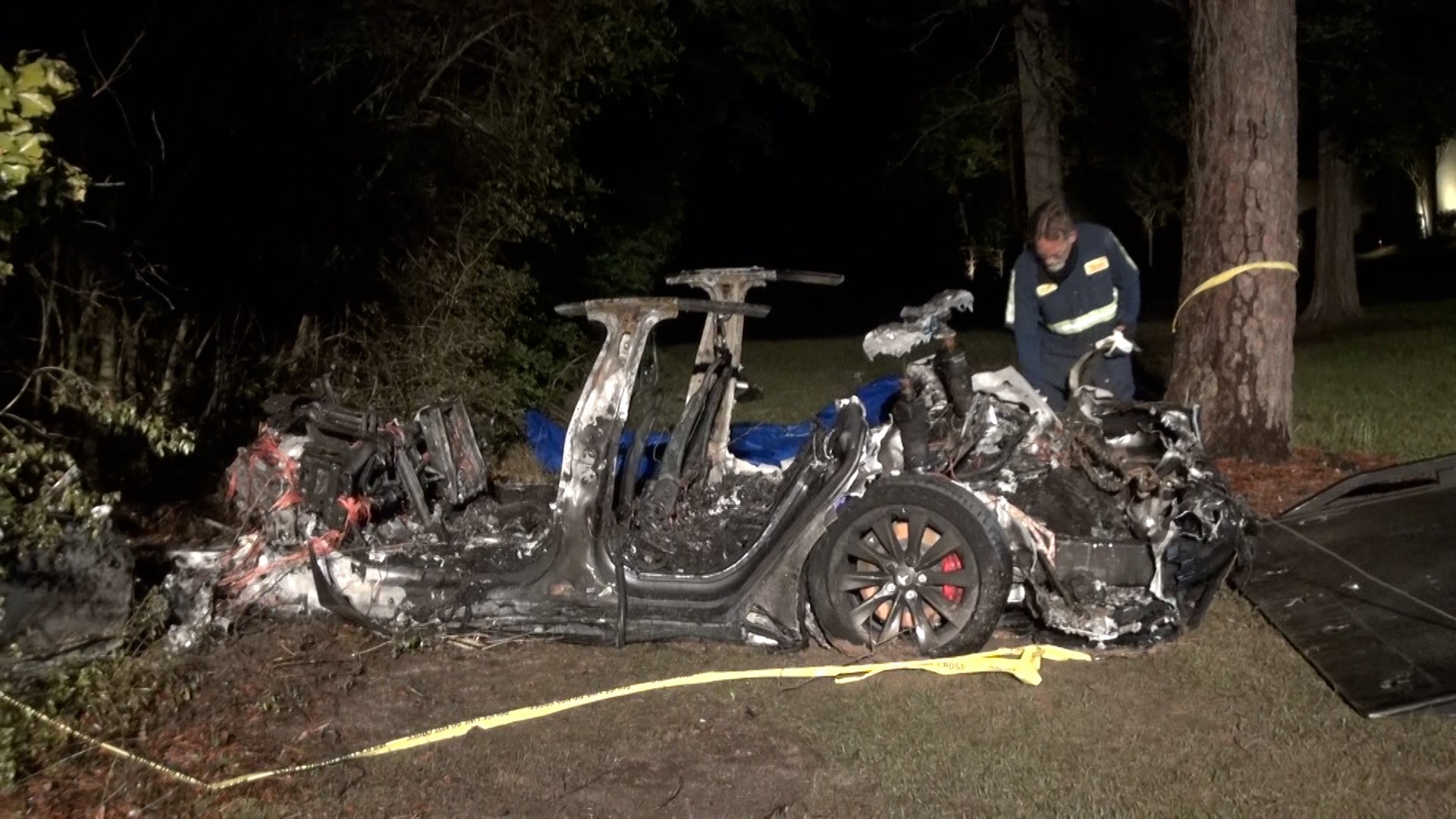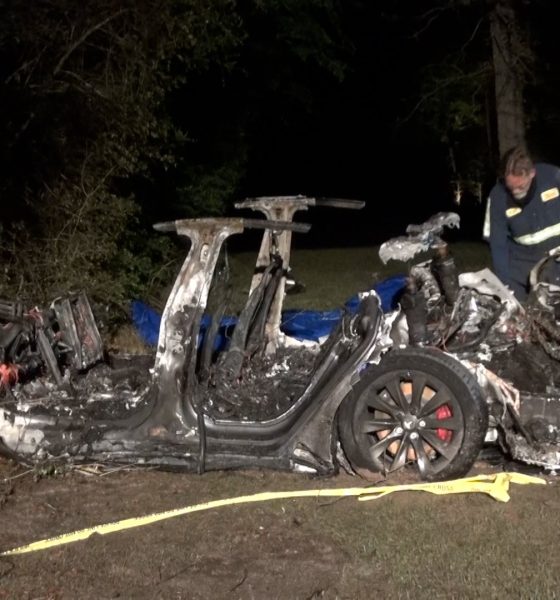This weekend, a tragic crash involving a 2019 Tesla Model S ended up claiming the lives of two individuals, a 59-year-old and a 69-year-old, both of whom are yet to be identified. Considering the nature of the case and partly due to the involvement of a Tesla, the incident has been covered by both local and national media outlets. This became quite notable in social media platforms, where the crash has been linked to Autopilot.
Two killed in huge blaze after driverless Tesla on autopilot crashes into tree https://t.co/JcwWM9hZAf pic.twitter.com/kvwUdg5ety
— New York Post (@nypost) April 18, 2021
This guide presents what is currently known about the tragic incident, as well as some commentary and videos from EV owners who have attempted to replicate (at least to a degree) the alleged events that led up to the tragic Model S crash.
What happened?
On Saturday night, a 2019 Model S crashed into a tree at about 11:25 p.m. in the Carlton Woods Subdivision on Hammock Dunes Place in Houston, Texas. According to authorities, the Model S crashed into a tree after failing to navigate a turn at high speed near 18 Hammock Dunes Place. The collision resulted in a fire that took the local fire department about four hours and over 30,000 gallons of water to extinguish. Investigators have found two victims from the incident, one sitting on the passenger seat and another in the back seat.
What did witnesses say?
KPRC 2 reporter Deven Clarke was able to speak to one of the victims’ brother-in-law, who stated that the Tesla owner and a friend simply wanted to take the car out for a spin. The brother-in-law remarked that there were just two people in the vehicle. He also added that the Tesla owner backed out of the driveway and then may have hopped in the back seat before crashing a few hundred yards down the road. The owner was reportedly the person found in the back seat of the car.
What has the police said?
In a statement to KHOU-11, Harris County Pct. 4 Constable Mark Herman remarked that deputies who recovered the Tesla are certain that the vehicle had no driver when it collided with the tree. He also emphasized that some of the authorities who responded to the incident were reconstructionists, and that they were very confident that there was no one driving the vehicle when it crashed.
“They are 100% certain that no one was in the driver seat driving that vehicle at the time of impact. They are positive. And again, the height from the back seat to the front seat, that would be almost impossible, but again our investigators are trained. They handle collisions. Several of our folks are reconstructionists, but they feel very confident just with the positioning of the bodies after the impact that there was no one driving that vehicle,” Herman said.
Was Autopilot involved?
Despite the inflammatory social media posts from some media outlets, it has not been determined yet if Autopilot had been active in the Model S when it collided with the tree. It should be noted that the roads in the Carlton Woods Subdivision on Hammock Dunes Place do not seem to have visible lane lines, which is a requirement for Autopilot’s activation. Regular cruise control could be activated in such areas as per videos from Tesla owners, but Autopilot and Full Self-Driving features are generally inaccessible in a residential area, at least in their current state.
This should dismiss the idea that AP was somehow the cause of this horrific incident. I pray for the family and friends of the deceased. Let’s trust the real investigators will discover what really happened here. pic.twitter.com/0tp8Vbh6fH
— Mikey Likes (@mliebow) April 18, 2021
Is the NTSB investigating the incident?
In a statement to Bloomberg, National Transportation Safety Board spokesperson Chris O’Neil confirmed that the NTSB does not plan to open a new probe about the tragic incident.
What happens when Autopilot is engaged and a driver unbuckles the seatbelt?
One scenario that has been suggested is that the driver might have activated Autopilot and jumped into the back seat. This would have been a tricky maneuver as the driver would have had to unbuckle himself, which results in Teslas engaging their alerts and eventually coming to a stop. Such a scenario was demonstrated by FSD Beta user @brandonee916.
Don’t hesitate to contact us for news tips. Just send a message to tips@teslarati.com to give us a heads up.

News
Tesla FSD fleet is nearing 7 billion total miles, including 2.5 billion city miles
As can be seen on Tesla’s official FSD webpage, vehicles equipped with the system have now navigated over 6.99 billion miles.

Tesla’s Full Self-Driving (Supervised) fleet is closing in on almost 7 billion total miles driven, as per data posted by the company on its official FSD webpage.
These figures hint at the massive scale of data fueling Tesla’s rapid FSD improvements, which have been quite notable as of late.
FSD mileage milestones
As can be seen on Tesla’s official FSD webpage, vehicles equipped with the system have now navigated over 6.99 billion miles. Tesla owner and avid FSD tester Whole Mars Catalog also shared a screenshot indicating that from the nearly 7 billion miles traveled by the FSD fleet, more than 2.5 billion miles were driven inside cities.
City miles are particularly valuable for complex urban scenarios like unprotected turns, pedestrian interactions, and traffic lights. This is also the difference-maker for FSD, as only complex solutions, such as Waymo’s self-driving taxis, operate similarly on inner-city streets. And even then, incidents such as the San Francisco blackouts have proven challenging for sensor-rich vehicles like Waymos.
Tesla’s data edge
Tesla has a number of advantages in the autonomous vehicle sector, one of which is the size of its fleet and the number of vehicles training FSD on real-world roads. Tesla’s nearly 7 billion FSD miles then allow the company to roll out updates that make its vehicles behave like they are being driven by experienced drivers, even if they are operating on their own.
So notable are Tesla’s improvements to FSD that NVIDIA Director of Robotics Jim Fan, after experiencing FSD v14, noted that the system is the first AI that passes what he described as a “Physical Turing Test.”
“Despite knowing exactly how robot learning works, I still find it magical watching the steering wheel turn by itself. First it feels surreal, next it becomes routine. Then, like the smartphone, taking it away actively hurts. This is how humanity gets rewired and glued to god-like technologies,” Fan wrote in a post on X.
News
Tesla starts showing how FSD will change lives in Europe
Local officials tested the system on narrow country roads and were impressed by FSD’s smooth, human-like driving, with some calling the service a game-changer for everyday life in areas that are far from urban centers.

Tesla has launched Europe’s first public shuttle service using Full Self-Driving (Supervised) in the rural Eifelkreis Bitburg-Prüm region of Germany, demonstrating how the technology can restore independence and mobility for people who struggle with limited transport options.
Local officials tested the system on narrow country roads and were impressed by FSD’s smooth, human-like driving, with some calling the service a game-changer for everyday life in areas that are far from urban centers.
Officials see real impact on rural residents
Arzfeld Mayor Johannes Kuhl and District Administrator Andreas Kruppert personally tested the Tesla shuttle service. This allowed them to see just how well FSD navigated winding lanes and rural roads confidently. Kruppert said, “Autonomous driving sounds like science fiction to many, but we simply see here that it works totally well in rural regions too.” Kuhl, for his part, also noted that FSD “feels like a very experienced driver.”
The pilot complements the area’s “Citizen Bus” program, which provides on-demand rides for elderly residents who can no longer drive themselves. Tesla Europe shared a video of a demonstration of the service, highlighting how FSD gives people their freedom back, even in places where public transport is not as prevalent.
What the Ministry for Economic Affairs and Transport says
Rhineland-Palatinate’s Minister Daniela Schmitt supported the project, praising the collaboration that made this “first of its kind in Europe” possible. As per the ministry, the rural rollout for the service shows FSD’s potential beyond major cities, and it delivers tangible benefits like grocery runs, doctor visits, and social connections for isolated residents.
“Reliable and flexible mobility is especially vital in rural areas. With the launch of a shuttle service using self-driving vehicles (FSD supervised) by Tesla in the Eifelkreis Bitburg-Prüm, an innovative pilot project is now getting underway that complements local community bus services. It is the first project of its kind in Europe.
“The result is a real gain for rural mobility: greater accessibility, more flexibility and tangible benefits for everyday life. A strong signal for innovation, cooperation and future-oriented mobility beyond urban centers,” the ministry wrote in a LinkedIn post.
News
Tesla China quietly posts Robotaxi-related job listing
Tesla China is currently seeking a Low Voltage Electrical Engineer to work on circuit board design for the company’s autonomous vehicles.

Tesla has posted a new job listing in Shanghai explicitly tied to its Robotaxi program, fueling speculation that the company is preparing to launch its dedicated autonomous ride-hailing service in China.
As noted in the listing, Tesla China is currently seeking a Low Voltage Electrical Engineer to work on circuit board design for the company’s autonomous vehicles.
Robotaxi-specific role
The listing, which was shared on social media platform X by industry watcher @tslaming, suggested that Tesla China is looking to fill the role urgently. The job listing itself specifically mentions that the person hired for the role will be working on the Low Voltage Hardware team, which would design the circuit boards that would serve as the nervous system of the Robotaxi.
Key tasks for the role, as indicated in the job listing, include collaboration with PCB layout, firmware, mechanical, program management, and validation teams, among other responsibilities. The role is based in Shanghai.
China Robotaxi launch
China represents a massive potential market for robotaxis, with its dense urban centers and supportive policies in select cities. Tesla has limited permission to roll out FSD in the country, though despite this, its vehicles have been hailed as among the best in the market when it comes to autonomous features. So far, at least, it appears that China supports Tesla’s FSD and Robotaxi rollout.
This was hinted at in November, when Tesla brought the Cybercab to the 8th China International Import Expo (CIIE) in Shanghai, marking the first time that the autonomous two-seater was brought to the Asia-Pacific region. The vehicle, despite not having a release date in China, received a significant amount of interest among the event’s attendees.










